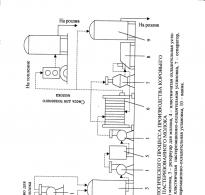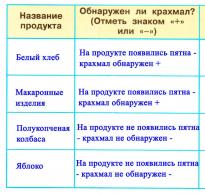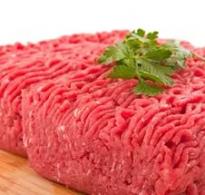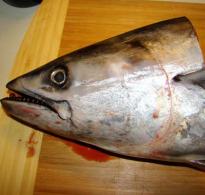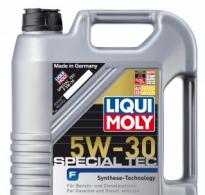How to turn vinegar essence into 9 vinegar. An elementary way using a faceted glass
Vinegar is a popular culinary seasoning, without which it is impossible to imagine the traditional preparation of vegetables for the winter, and the preparation of many dishes. However, in the preparation of marinades, keeping the proportions in the dilution of vinegar plays an important role. Too high a concentration of this seasoning can not only spoil the taste of the prepared dish, but also cause severe poisoning.
Therefore, less concentrated vinegar is often needed. Let's find out how to dilute 70% vinegar to 9%.
What is vinegar?
Vinegar is classified into two types: natural and synthetic. Natural vinegar is obtained by fermenting various liquids containing alcohols. It can be wine, apple, herbal, fruit and berry.
Ordinary vinegar is synthetic. The main component in it is acetic acid, obtained by chemical processes based on wood distillation products, natural gas and some industrial by-products.
Ideally, of course, it is necessary to eat natural vinegar, and synthetic vinegar is intended for domestic needs: disinfection, stain removal and others. However, in our kitchens, vinegar is widely used for making marinades.
The most economical option is to use 70% vinegar essence, which must be diluted to a certain concentration. In particular, we have prepared several options with which you will learn how to dilute 70% vinegar to 9%.
Rules for diluting vinegar to the desired concentration
Every time before preparing a dish or using vinegar essence in cosmetology or at home, the hostess faces the question: in what proportion should the concentrated solution be diluted to the desired state and how 70% vinegar should be diluted to 9%.
Let's say you have an essence at 80% concentration.
If we need a 3% solution, then add 25 parts of water to one part of the essence. If it is necessary to obtain 6% vinegar, the ratio is 1: 12.5. A 9% solution is obtained if the essence is diluted with water in a ratio of one to seven.
The use of 70% vinegar essence requires other proportions when diluting it: dilute like 70% vinegar to 9%.
To obtain a 3% vinegar solution, add 22 parts of water to one part of the essence. And for a 6% solution - accordingly - the ratio is 1:11. 9% vinegar is obtained by adding 5.5 parts of water to part of the essence.
When diluting vinegar essence, which is unsafe to use, certain rules must be followed. Store this aggressive liquid, which can cause burns and corrode tissues, only in a glass container tightly sealed with a cork. The essence must be poured from the bottle gently, without splashing. An important rule: we pour the essence into water and in no case is it the other way around. When pouring, do not bend over strongly to containers with concentrated liquid in order to avoid inhaling harmful vapors.
Cooking, medicine, home cosmetology, household - in all these areas of our life, vinegar plays an important role and the rules for handling it should be familiar to every housewife.
For the preparation of marinades, table vinegar is often used. Therefore, situations may arise where the knowledge of how to get 9% vinegar from 70% acetic acid. To do this, just use a special table and follow a few simple tips.
Safety regulations
But before looking at the table, you need to familiarize yourself with the safety rules:
- We dilute the initial composition exclusively with cold water - filtered, boiled, but not from the tap.
- Do not drink, eat, or chew gum during the process. This increases the chances of getting the essence on the mucous membranes, which will need to be rinsed immediately with plenty of running water.
- We use only measuring spoons and cups in our work. When diluting acetic acid, precision is essential. If you make a little mistake, the final product may be spoiled.
- Vinegar evaporates fairly quickly in the air, so at the final stage, you should tightly close the storage container and hide it in a dark and cool place.

What else needs to be remembered
A simple mathematical formula will help you make 9% vinegar at home. It can also be used in situations where a higher or lower strength composition needs to be prepared.
Do you like vinegar?
To vote
"70/9 = 7.7"- based on these data, it is quite simple to calculate the proportions. It is enough to dilute 1 tablespoon of acetic acid with 7 tablespoons of cold water. They are gently mixed several times, and the output is table vinegar.

Additional information
When the question arises of how to get 9% vinegar from 70% acetic acid, it is worth using a special table for greater convenience, which indicates the necessary proportions for preparing different types of the final product:
|
Required fortress |
Amount of ingredients (in tablespoons) |
|
10% vinegar solution |
Dilute 1 tablespoon with 6 tablespoons of water |
|
9% vinegar solution |
Dilute 1 tablespoon with 7 tablespoons of water |
|
8% vinegar solution |
Dilute 1 tablespoon with 8 tablespoons of water |
|
7% vinegar solution |
Dilute 1 tablespoon with 9 tablespoons of water |
|
6% vinegar solution |
Dilute 1 tablespoon with 11 tablespoons of water |
|
5% vinegar solution |
Dilute 1 tablespoon with 13 tablespoons of water |
|
4% vinegar solution |
Dilute 1 tablespoon with 17 tablespoons of water |
|
3% vinegar solution |
Dilute 1 tablespoon with 22.5 tablespoons of water |
|
20% vinegar solution |
Dilute 1 tablespoon with 2.5 tablespoons of water |
|
30% vinegar solution |
Dilute 1 tablespoon with 1.5 tablespoons of water |
As you can see, getting the product you need at home is not difficult at all. But it is best to use this method only in an emergency, so as not to endanger your health and to be sure that the taste does not suffer.
Essence is a solution of food grade acetic acid. In the case of its use, severe burns of the mucous membranes of the oral cavity and stomach occur. Therefore, this product is not used in its pure form. In the food industry, it is used as an E260 additive, and in the household - for the preparation of table vinegar, pickles and canned foods.
You can make 9% vinegar from the essence by diluting it with a certain amount of water. However, it is not enough just to calculate the ratio of essence and liquid - it is also necessary to take into account that the density of these liquids is different, so you need to know the exact calculation formula.
Fast navigation through the article
Vinegar 9%
9% vinegar is widely used for the preparation of various marinades in conservation. It can be made from essences of 80%, 70% or 30%:
- If the initial concentration of acetic acid is 80%, then for 1 part you need to take 8 parts of water (for example, 1 glass of essence and 8 glasses of water);
- If the initial concentration of acetic acid is 70%, then for 1 part it is necessary to take 7 parts of water (for example, mix 1 spoon of essence and 7 tablespoons of water);
- If the initial concentration of acetic acid is 30%, then for 1 part you need to take 2 parts of water (for example, mix 0.5 l of essence and 1 l of water).
Vinegar 3%
3% vinegar is perfect for dressing salads and other dishes. To prepare it from essences of different concentrations, you must adhere to the appropriate proportion:
- 1 part 80% vinegar essence + 25.5 parts water;
- 1 part 70% vinegar essence + 22 parts water;
- 1 part 30% vinegar essence + 9 parts water.
In order not to be mistaken in the amount of liquids to be mixed, it is best to use a large pharmaceutical syringe - with its help it is easy to measure the required amount of water and essence in ml.
Vinegar 5%
For dressings and sauces (for example, dumplings), 5% vinegar is best. You can make it from vinegar essence as follows:
- Mix 1 part 80% essence and 15 parts water;
- Mix 1 part 70% essence and 13 parts water;
- Mix 1 part 30% essence and 5 parts water.
For ease of calculation, it is best to use small measuring cups with an indication of the volume.
Vinegar 6%
Most often 6% vinegar is used for marinating meat. In order to dilute the vinegar essence to the required concentration, it is necessary to adhere to the following ratios:
- Add 1 part 80% acetic acid to 12 parts of water;
- Add 1 part 70% acetic acid to 10.5 parts of water;
- Add 1 part 30% acetic acid to 4 parts water.
You can measure the amount of water and essences using ordinary glasses or small glasses.
Vinegar 10%
To make canned foods more pungent and richer, 10% vinegar is used. You can make it from different essences:
- Stir 1 part 80% essence with 7 parts water;
- Stir 1 part 70% essence with 6 parts water;
- Stir 1 part 30% essence with 2 parts water.
It is preferable to measure the amount of liquid in measuring containers, so as not to be mistaken in the proportion.
Vinegar 30%
Most often, highly concentrated 30% vinegar is used for domestic purposes (wash off rust on the tap, get rid of water scale in a kettle, etc.). You can make it using the essence:
- Mix 1 part 80% essence and 1.5 part water;
- Mix 1 part 70% essence and 1 part water.
The resulting solution should be diluted and used very carefully: do not inhale the fumes from it and try to avoid contact with the skin.
Vinegar is a versatile culinary aid. It is used as a salad dressing, as a dough component, and, of course, as an indispensable ingredient for preservation. In addition, it is useful in everyday life - for removing various kinds of dirt from many surfaces, scale, unpleasant odors. But if you only have the essence on hand, how to make 9% vinegar from 70%? In this article, we will answer this question in detail.
Safety engineering
Yes, yes, before you learn how to make 9% from 70% vinegar, we remind you once again that vinegar essence is a product dangerous to health and even human life if handled improperly.
Therefore, always remember the following:
- You should have enough cold drinking water on hand.
- While working with aggressive essence, it is not recommended to drink other drinks or eat.
- Before making 9% vinegar from 70% vinegar essence, check that you have a special measuring cup. Determination of volume "by eye", with spoons or other containers, is not suitable.
- If vinegar or essences get on the skin, mucous membranes, or in the eyes, immediately rinse the affected area with plenty of running water!
- It will be harmful to humans and for a long time to inhale vapors of concentrated acetic acid - this can lead to burns of the respiratory tract.
- The prepared solution will tend to evaporate quickly, so store it in a closed container away from direct sunlight.
Making vinegar from essence
If the vinegar essence is decomposed into parts, then 0.3 of 1 will be water, and 0.7 of 1 will be acid. By simple calculations, you can find out that from a teaspoon of the essence by diluting with water, you can get a quarter of a glass of vinegar. From this, diluting it from acetic acid comes out much more economical than buying a 6%, 7%, 9% solution.
How to make 9% vinegar from 70% acid? We need to dilute 1 tablespoon of the essence with 7 tablespoons of water. Or 1 glass of acetic acid with 7 glasses of drinking water. This is obtained from the following simple formula:
70% / 9% = 7.7 (round to 7).

For other concentrations of vinegar essence, the following calculations will be correct to obtain 9% vinegar:
- 80% essence: for one part of acid, eight parts of water.
- 30% essence: for one part of acid, two parts of water.
We have given more detailed calculations in the next subheading.
How to make 9% vinegar from 70% essence: formula
Do not rush to use the entire bottle of essence to make vinegar. Let's first calculate how much 70% acetic acid we need. To do this, you can use a simple formula:
E = (K y * O y) / K e, where:
E - the volume of the essence;
K y - the concentration of vinegar you need;
About y - the required volume of vinegar solution;
K e - the concentration (%) of the essence you have.
How to make 9% vinegar from 70% using this formula? Let's say we need 50 ml of vinegar. Now all the values for the formula are:
E = (9 (%) * 50 (ml)) / 70 (%).

After performing simple calculations, we find that we need 6.4 ml of 70% vinegar essence. The rest of the volume, that is, 43.6 ml (50 ml - 6.4 ml), we replenish with cold drinking water.
Measuring table
Not everyone in a hurry wants to deal with calculations and formulas. Therefore, for your convenience, we have compiled the following handy table, which will tell you how to make 9% vinegar from 70% and not only. This shows how many parts of water are taken for one part of the essence to obtain the desired concentration of vinegar.
| Essence concentration | Vinegar concentration | |||||
| 30% | 10% | 9% | 6% | 5% | 3% | |
| 30% | - | 2 | 2 | 4 | 5 | 9 |
| 70% | 1 | 6 | 7 | 10,5 | 13 | 22 |
| 80% | 1,5 | 7 | 8 | 12 | 15 | 25,5 |
The table is easy to use. For example, you need to get 10% vinegar from 80% essence. To do this, dilute 1 tablespoon of acetic acid with 7 tablespoons of water.
Types of vinegar and essences
Vinegar is a product of souring fruit or berry juices and wines. In each country, depending on the climate and typical fruit plantings, its own kind of vinegar is popular. In Russia, for example, it is apple. But about how to make 9% vinegar from 70%, you can tell about a number of other essences that have their own distinctive features. For instance:
- Balsamic. The most ancient recipe - humanity has been preparing it for a whole millennium! It is infused in wooden barrels to a viscous consistency. Vinegar has an unusual dark color and rich, but mild taste.
- Wine white vinegar. A product of processing white wines. In many countries, it is appreciated for its special piquant taste.
- Red wine vinegar and its rarer variety, pink. It is already obtained from red wine varieties - merlot, malbec, cabernet.
- Apple. A popular product in our latitudes with a characteristic amber hue and tart sour taste. Raw materials - apple cake or cider.

- Sherry. The most expensive and rare type of vinegar. The process of its production is lengthy and complicated, and its raw material is an expensive wine made from Palomino Fino grape berries.
- In some countries, coconut, malt, and rice wine vinegar is also popular.
In conclusion, let us warn you once again that you need to be extremely careful when working with vinegar essence. Never try it undiluted! Store this product in a container with an explanatory label and out of the reach of children.
Some housewives are prejudiced against vinegar, naively believing that it is needed only in the summer and autumn months, for the period of pickling vegetables. Vinegar essence is an irreplaceable assistant in the kitchen for any housewife, both beginner and experienced.
Vinegar is not just for vegetables
You can't start the dough without, and you can't marinate meat or fish, and you can't make delicious salads "in Korean". In short, vinegar is an irreplaceable thing. Most of us have 70% concentration of vinegar stored at home. It doesn't fit everywhere.
Why pay more?
On the shelves of the store you can find diluted vinegar - 6, 7, 9 percent. This means that the manufacturers have already tried for you and diluted to the required concentration. That is, you have to pay for water. And many are willing to overpay because they do not know the essence of up to 9% vinegar. And for most dishes, vinegar is required in this concentration. How to be?
What's on the bottle?
First, you need to take a good look at the label of the bottle you bought. You must be clear about what you bought. Only then can you look for information, for example, how to dilute vinegar essence from 80% to 9% vinegar. Depending on what concentration of the substance you have purchased, you will need to add a strictly measured amount of water. The instruction on how to dilute 70% vinegar essence to 9% vinegar is noticeably different. The table can be shown on the label itself. Usually there are measurements in grams, but not every housewife has such accurate scales or measuring instruments in the kitchen. Measure with a teaspoon or tablespoon. Remember that 5 grams of liquid fits in, in a dining room - up to 18, provided that the spoon is filled to the brim.

Remembering the school curriculum
If there is no instruction on the bottle label, then you will have to go back to your school years and calculate the proportions yourself. It's not that hard.
So, for example, we need to learn how to dilute vinegar essence to 9% vinegar. Our original liquid contains 70% vinegar. We need exactly 100 ml of the diluted liquid. Thus, you get the equation:
Where 9 is the concentration of vinegar we need, 100 is the required amount of vinegar in the end, 70 is the concentration of the essence, and "x" is its amount.

To solve the equation, you need to multiply the numbers diagonally from bottom to top among themselves (9 * 100) and divide by the top number from the other diagonal (70).
That is, (100 * 9) / 70 = (approximately) 12.5.
Therefore, to get 100 ml of 9% vinegar, you need to take a little less than a tablespoon of 70% vinegar and add the amount of water to make exactly 100 ml.
Let's take another tricky formula that looks like this in writing:
k = (k1-k2) / k2.
Let's write down the legend.
O is the amount of vinegar we have;
Ov is the volume of water that we add to the essence;
k1 - denotes the concentration of available vinegar in percent;
k2 - the desired concentration of vinegar in the outcome.
From 80% vinegar, we need to get 9. (80-9) / 9 = 7.8.
Thus, we determine that to obtain a 9% concentration from 80%, we need to take approximately 8 parts of water and 1 part of vinegar essence. Any of the same measure can be a part - a tablespoon, a teaspoon, a glass, etc.

1. Need a 30% concentrated solution? Dilute in a ratio of 1: 1.5, where 1 part is essence, 1.5 is water.
2. To make vinegar with 10% acidity, you must mix 1 part of 70% essence with 6 parts of water.
3. How to dilute vinegar essence to 9% vinegar? The table suggests that you need to mix water with vinegar essence in a 7 to 1 ratio.

4. To end up with a solution of 8% vinegar, you need to combine 8 parts of water with one part of the essence.
5. If the mixing ratio is 1: 9, you get 7% vinegar.
6. A slightly acidic 6% solution is made according to the scheme 1 to 11.
7. If you add 1 part 70% vinegar to plain water (13 parts), you will get a 5% solution.
8. By increasing the amount of water to 17 parts, prepare 4% vinegar.
After reading and familiarizing yourself with all these simple methods, you will no longer be perplexed if you suddenly come across low concentration vinegar in the list of required ingredients. As a last resort, use online calculators.

